

Top 9 ethical issues in artificial intelligence. Gartner Reprint. 25 February 2016 | ID:G00275472 Analyst(s): Roxane Edjlali, Mark A.

Beyer Summary Disruption is accelerating in this market, with more demand for broad solutions that address multiple types of data and offer distributed processing and repository options. Market Definition/Description This document was revised on 29 February 2016. Thriving in an Increasingly Digital Ecosystem. Zukunft der Arbeit: Uns braucht es bald nur noch als Konsumenten - NZZ NZZ am Sonntag. Top 50 SAP Employees by Twitter Followers 2014. Comparing Data Warehouse Solutions. The Future of Analytics Depends on IBM - and Vice Versa! IBM is again at a crossroads as its stock price languishes and market analysts question if it is on the right path.
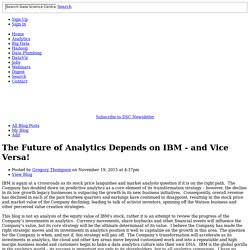
The Company has doubled down on predictive analytics as a core element of its transformation strategy – however, the decline in its low growth legacy businesses is outpacing the growth in its new business initiatives. Consequently, overall revenue has declined in each of the past fourteen quarters and earnings have continued to disappoint, resulting in the stock price and market value of the Company declining; leading to talk of activist investors, spinning off the Watson business and other perceived value creation strategies.
This blog is not an analysis of the equity value of IBM’s stock, rather it is an attempt to review the progress of the Company’s investments in analytics. October Microsoft BI World News. Magic Quadrant for Data Integration Tools. 29 July 2015 ID:G00269320 Analyst(s): Eric Thoo, Lakshmi Randall Enterprise buyers increasingly see data integration as a strategic requirement, for which they want comprehensive data delivery capabilities, flexible deployment models, and synergies with information and application infrastructures.
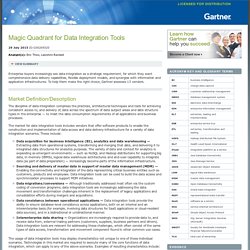
To help them make the right choice, Gartner assesses 13 vendors. Market Definition/Description The discipline of data integration comprises the practices, architectural techniques and tools for achieving consistent access to, and delivery of, data across the spectrum of data subject areas and data structure types in the enterprise — to meet the data consumption requirements of all applications and business processes. Data Warehousing. Why BI isn’t ready for the cloud.
You’ve heard it again and again: The cloud is the new black.
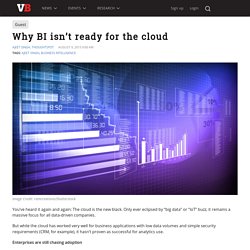
Only ever eclipsed by “big data” or “IoT” buzz, it remains a massive focus for all data-driven companies. But while the cloud has worked very well for business applications with low data volumes and simple security requirements (CRM, for example), it hasn’t proven as successful for analytics use. Enterprises are still chasing adoption Over the last two decades, companies have collectively spent billions of dollars on business intelligence tools. I recently learned about a large financial services company that owns 92 analytics tools across different departments and geographies. Deployment efficiency leans heavily toward on-premise. Top 10 2015 Predictions for Microsoft Azure. Like Office 365, Microsoft Azure has undergone a lot of change in the past year.
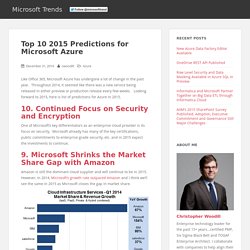
Throughout 2014, it seemed like there was a new service being released in either preview or production release every few weeks. Looking forward to 2015, here is list of predictions for Azure in 2015. One of Microsoft’s key differentiators as an enterprise cloud provider is its focus on security. Microsoft already has many of the key certifications, public commitments to enterprise grade security, etc. and in 2015 expect the investments to continue.
Amazon is still the dominant cloud supplier and will continue to be in 2015. BI Manager. Aggregation and Redundancy-Free Business. I recently participated in the Very Large Data Bases Conference (VLDB), the #1 ranked academic research conference in the database field, hosted in Hangzhou, China.

During this conference, Professor Dr. Hasso Plattner delivered the keynote presentation: “The Impact of Columnar In-Memory Databases on Enterprise Systems”. Hasso Plattner shared visions of future enterprise applications to be aggregation and redundancy free; fundamentally changing business applications. SAP Shares Analytics Vision, Lumira, BI 4.2 Details at ASUG’s SABOC Event. SAP offered new product information and key BusinessObjects roadmap details—covering BI suite consolidation, HANA tie-ins, BI 4.2 and Lumira enhancements—during the first day of ASUG’s SAP Analytics & BusinessObjects Conference in Ft.
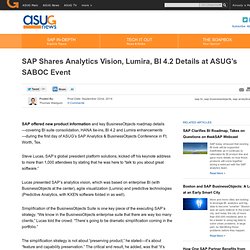
Worth, Tex. Steve Lucas, SAP’s global president platform solutions, kicked off his keynote address to more than 1,000 attendees by stating that he was here to “talk to you about great software.” Lucas presented SAP’s analytics vision, which was based on enterprise BI (with BusinessObjects at the center), agile visualization (Lumira) and predictive technologies (Predictive Analytics, with KXEN software folded in as well). Simplification of the BusinessObjects Suite is one key piece of the executing SAP’s strategy. “We know in the BusinessObjects enterprise suite that there are way too many clients,” Lucas told the crowd. The simplification strategy is not about “preserving product,” he stated—it’s about “feature and capability preservation.” MGI_big_data_exec_summary. Big Data Meets Trough Of Disillusionment: Gartner. Gartner says cloud, in-memory databases are headed into Hype Cycle "trough of disillusionment.

" Productivity expected within two to five years.
News. IT Trends For 2013. Metatrends_bi_competence_site.pdf. Trends. Disruptive technologies: Advances that will transform life, business, and the global economy. The relentless parade of new technologies is unfolding on many fronts.

Almost every advance is billed as a breakthrough, and the list of “next big things” grows ever longer. Not every emerging technology will alter the business or social landscape—but some truly do have the potential to disrupt the status quo, alter the way people live and work, and rearrange value pools. It is therefore critical that business and policy leaders understand which technologies will matter to them and prepare accordingly.
Disruptive technologies: Advances that will transform life, business, and the global economy, a report from the McKinsey Global Institute, cuts through the noise and identifies 12 technologies that could drive truly massive economic transformations and disruptions in the coming years. The report also looks at exactly how these technologies could change our world, as well as their benefits and challenges, and offers guidelines to help leaders from businesses and other institutions respond.